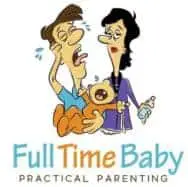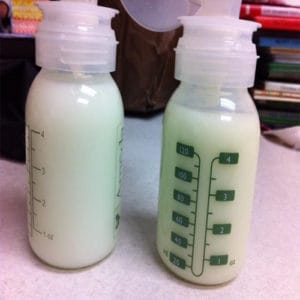As you've probably gathered from childbirth, a mother's body isn't always a perfectly calibrated machine, designed with nano precision. Breastfeeding works on a supply and demand basis, and understanding this can help with many of the common problems that crop up. Oversupply of breastmilk is one of the issues that is often less discussed.
Too much breastmilk? Is that even a problem? Hyperlactation refers to when mom produces an excessive amount of breast milk. This likely isn't an issue unless your baby is clearly uncomfortable nursing.
Hyperlactation Causes
Milk production is like a dance. The amount that mothers make is entirely dependent on the amount removed from the breast. Most babies and moms are capable of figuring out an equilibrium as long as mom takes cues from the baby. When oversupply happens there are a few likely culprits:
- Overstimulation - A common solution offered may be to pump milk , though this would actually stimulate more milk production
- Misdiagnosis - Because babies may appear constantly hungry but not satisfied, some mothers may even try to enhance milk production
- Breastfeeding mismanagement - Arbitrary rules introduced culturally may cause mothers to get into a cycle of increasing milk production
- Hormonal imbalances
- Medical causes
- Medications
Signs of Hyperlactation in Mom
- Tender leaking breasts
- Sore infected nipples
- Breasts feel engorged all of the time
- Milk ducts become plugged
- Breast tissue is inflamed and painful, which is called mastitis
Signs of Hyperlactation in Baby
- Choke, gag, gasp, cough, or gulp the breast milk that is released too quickly from the breast
- Continuously pull off of the breast, cry or protest during a feeding
- Constantly act hungry, nursing frequently
- Tugging or pinching the breast while feeding, in an effort to slow milk flow, sometimes at the expense of mom's nipples
- Pulling off the breast abruptly
- Spit up or pass gas quite often during and after a feeding
- Weight gain much faster than normal
- Suckling with a loose latch to accommodate high speed flow
How Can There Be Oversupply If My Baby's Always Hungry?
If a mom has an oversupply of breast milk, the baby may end up with more foremilk and not enough hindmilk. Both foremilk and hindmilk are the same type of milk, but the hindmilk that comes out towards the end of a feeding has a higher fat content.
The foremilk typically has lower caloric content in higher volumes, while the creamier hindmilk is lower in volume with higher fat content. This additional fat content is from the fat globules that dislodge once a breast is almost empty, which are released through the hindmilk. The fats help the stomach to absorb the lactase in the milk.
If a baby loads up on foremilk without enough hindmilk, they may not only end up "hungry" quickly, but show signs of reflux, gas, or symptoms of colic.
What Mom Can Try
A word of caution: sometimes breastfeeding problems can be exacerbated by breastfeeding mismanagement. That means trying to apply feeding rules based on cultural norms, like putting a baby on a schedule feeding every 4 hours. Do NOT try to reduce your supply during the first 4-6 weeks.
When in doubt the first rule of thumb should be to watch your baby and seek professional help if you believe there's a serious problem.
There are a few tactics moms typically try to reduce the irritation for their babies.
- Anti Gravity Nursing Positions - Not an alternative blockbuster movie, this method simply uses gravity in your favor to fight forceful let down. Side lying and laid back positions are common, as is any position where the mom can lean back. If your baby is sitting up while nursing that may help as well.
- Before each feeding, a mom can hand express a little milk from the breast she will be feeding from. This should lessen the letdown and make it more manageable for the nursing baby.
- Attempt to feed the baby before the baby is really hungry. This will prevent the baby from sucking too hard on the breast. Gentle sucking is less stimulating and may lessen the flow of the breast milk.
- Block Feeding - Try nursing your baby on one breast for one or two feedings to completely drain that breast and then do the same on the other side. This allows complete emptying of each breast, ensuring that babies reach the hindmilk. Mothers have been known to apply a set amount of time, switching breasts only after every 3 hours, or every 5 hours and so on. This signals less milk production in the breasts, so if you're going to try this you should really be certain that oversupply is your problem.
- Stop pumping breast milk for storage until the milk supply matches the baby’s needs
- Also, if there is a time when their baby seems to be choking on breast milk or gasping while nursing, the mom should immediately remove them from her breast and burp them. This will give the baby a chance to remove additional air from their belly before they continue eating.
Conclusion
Since an oversupply of milk usually happens when a baby is only a few weeks old, it is recommended by the La Leche League to not do too much to reduce a mom’s breast milk supply right away. It takes time for the mom’s body to adjust to their baby’s needs when it comes to breast milk production. A mom should hand express a little of their letdown, try a different nursing position with their baby, and burp their baby frequently until their breast milk supply adjusts.
If there's still hyperlactation after the first 4-6 weeks, then you will may want to see a lactation consultant to properly diagnose the condition and find treatment tactics.
Citations
http://digitalcommons.fairfield.edu/cgi/viewcontent.cgi?article=1006&context=nursing-facultypubs




